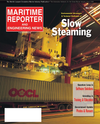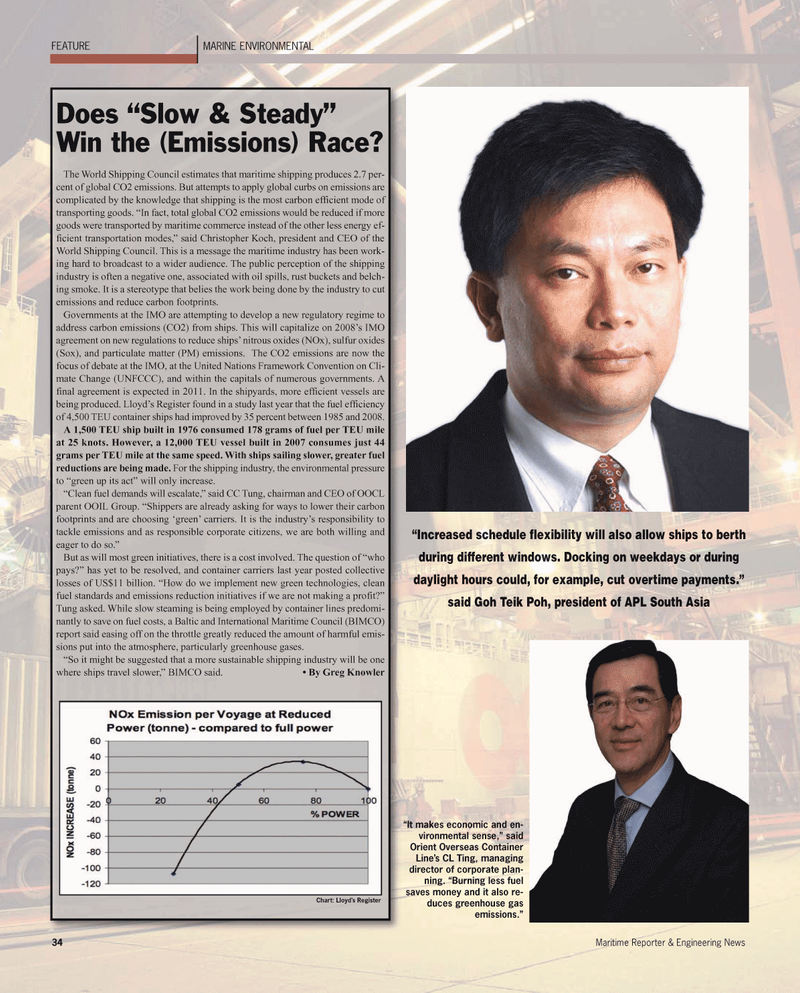
Page 34: of Maritime Reporter Magazine (May 2, 2010)
Read this page in Pdf, Flash or Html5 edition of May 2, 2010 Maritime Reporter Magazine
34 Maritime Reporter & Engineering News
Does “Slow & Steady”
Win the (Emissions) Race?
The World Shipping Council estimates that maritime shipping produces 2.7 per- cent of global CO2 emissions. But attempts to apply global curbs on emissions are complicated by the knowledge that shipping is the most carbon efficient mode of transporting goods. “In fact, total global CO2 emissions would be reduced if more goods were transported by maritime commerce instead of the other less energy ef- ficient transportation modes,” said Christopher Koch, president and CEO of the
World Shipping Council. This is a message the maritime industry has been work- ing hard to broadcast to a wider audience. The public perception of the shipping industry is often a negative one, associated with oil spills, rust buckets and belch- ing smoke. It is a stereotype that belies the work being done by the industry to cut emissions and reduce carbon footprints.
Governments at the IMO are attempting to develop a new regulatory regime to address carbon emissions (CO2) from ships. This will capitalize on 2008’s IMO agreement on new regulations to reduce ships’ nitrous oxides (NOx), sulfur oxides (Sox), and particulate matter (PM) emissions. The CO2 emissions are now the focus of debate at the IMO, at the United Nations Framework Convention on Cli- mate Change (UNFCCC), and within the capitals of numerous governments. A final agreement is expected in 2011. In the shipyards, more efficient vessels are being produced. Lloyd’s Register found in a study last year that the fuel efficiency of 4,500 TEU container ships had improved by 35 percent between 1985 and 2008.
A 1,500 TEU ship built in 1976 consumed 178 grams of fuel per TEU mile at 25 knots. However, a 12,000 TEU vessel built in 2007 consumes just 44 grams per TEU mile at the same speed. With ships sailing slower, greater fuel reductions are being made. For the shipping industry, the environmental pressure to “green up its act” will only increase. “Clean fuel demands will escalate,” said CC Tung, chairman and CEO of OOCL parent OOIL Group. “Shippers are already asking for ways to lower their carbon footprints and are choosing ‘green’ carriers. It is the industry’s responsibility to tackle emissions and as responsible corporate citizens, we are both willing and eager to do so.”
But as will most green initiatives, there is a cost involved. The question of “who pays?” has yet to be resolved, and container carriers last year posted collective losses of US$11 billion. “How do we implement new green technologies, clean fuel standards and emissions reduction initiatives if we are not making a profit?”
Tung asked. While slow steaming is being employed by container lines predomi- nantly to save on fuel costs, a Baltic and International Maritime Council (BIMCO) report said easing off on the throttle greatly reduced the amount of harmful emis- sions put into the atmosphere, particularly greenhouse gases. “So it might be suggested that a more sustainable shipping industry will be one where ships travel slower,” BIMCO said. • By Greg Knowler
FEATURE MARINE ENVIRONMENTAL “Increased schedule flexibility will also allow ships to berth during different windows. Docking on weekdays or during daylight hours could, for example, cut overtime payments.” said Goh Teik Poh, president of APL South Asia “It makes economic and en- vironmental sense,” said
Orient Overseas Container
Line’s CL Ting, managing director of corporate plan- ning. “Burning less fuel saves money and it also re- duces greenhouse gas emissions.”
Chart: Lloyd’s Register

 33
33

 35
35
